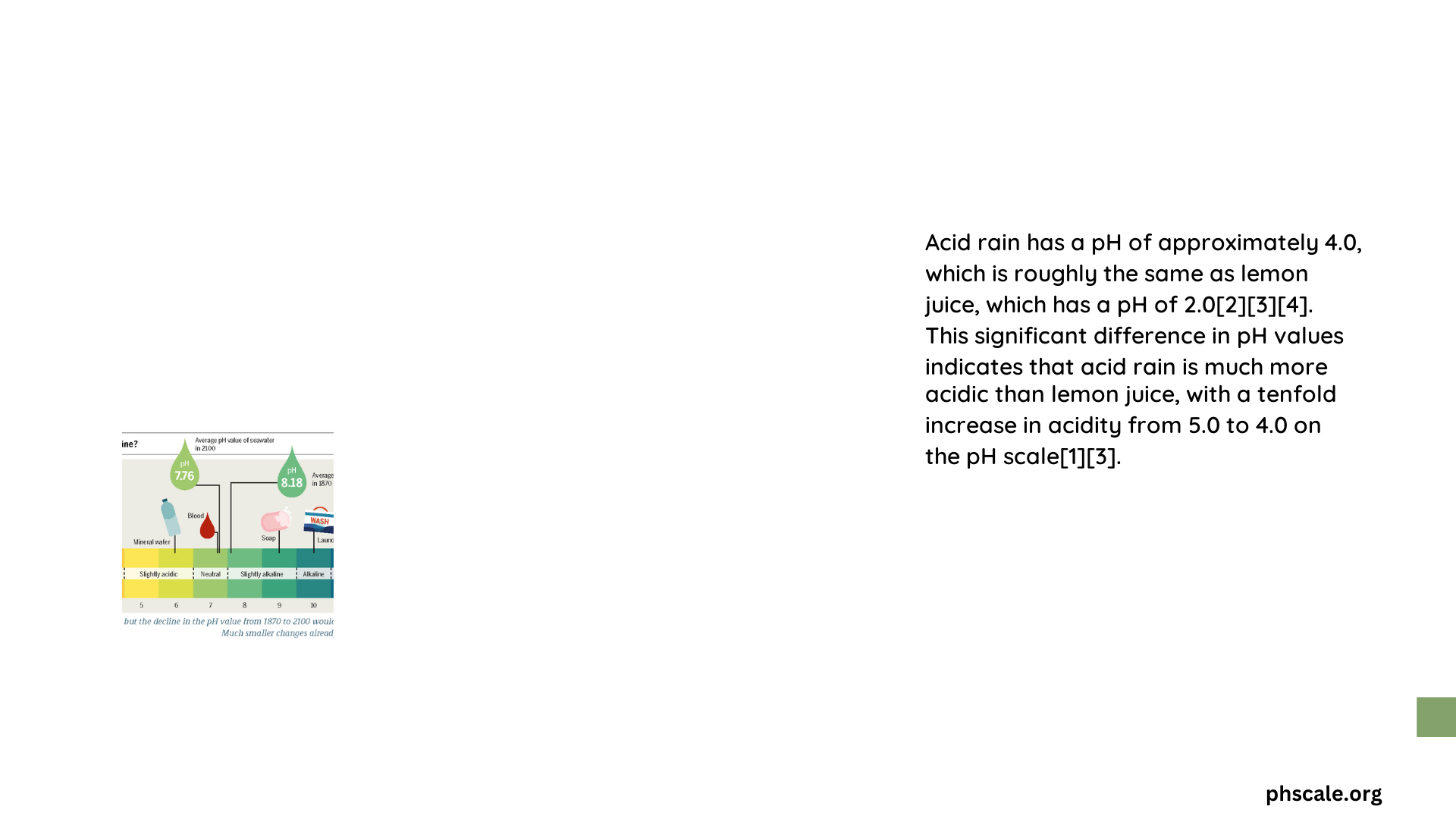Acid rain, a phenomenon caused by air pollution, has a pH level that can vary significantly depending on environmental factors. While it’s generally more acidic than normal rainwater, its pH is often compared to common household items for better understanding. This article explores the acidity of acid rain and compares it to various juices, particularly lemon juice, to provide a relatable context for its environmental impact.
What is the Typical pH Range of Acid Rain?
Acid rain typically has a pH range between 4.5 and 5.6, though it can be as low as 2.6 in highly polluted areas. Normal rainwater, by comparison, has a pH of about 5.6 due to dissolved carbon dioxide forming carbonic acid. The acidity of acid rain can vary based on location and pollution levels:
- Eastern United States and Canada: pH 4.2 to 5.0
- Base of clouds in Eastern U.S. during summer: Average pH as low as 3.6
- Highly polluted cities (fog): pH as low as 2.0
How Does Acid Rain’s pH Compare to Common Juices?

To understand the acidity of acid rain in relatable terms, let’s compare it to some common fruit juices:
| Substance | Typical pH Range |
|---|---|
| Acid Rain | 4.5 – 5.6 (can be as low as 2.6) |
| Lemon Juice | 2.0 – 2.5 |
| Orange Juice | 3.3 – 4.2 |
| Apple Juice | 3.3 – 4.0 |
| Grape Juice | 3.3 – 3.5 |
As we can see, acid rain is generally less acidic than most fruit juices. However, in extreme cases, its acidity can approach that of lemon juice.
Why is Lemon Juice Often Used as a Comparison for Acid Rain?
Lemon juice is frequently used as a comparison point for acid rain due to several factors:
- Familiarity: Most people are familiar with the sour taste of lemon juice, making it a relatable reference.
- High Acidity: With a pH of 2.0 to 2.5, lemon juice is one of the most acidic common household substances.
- Comparable pH in Extreme Cases: In highly polluted areas, acid rain can have a pH as low as 2.6, which is close to that of lemon juice.
What Are the Environmental Effects of Acid Rain?
The acidity of acid rain, while not always as extreme as lemon juice, can still have significant environmental impacts:
- Soil Degradation: Leaches nutrients and increases toxic aluminum availability
- Water Body Acidification: Reduces biodiversity in lakes and streams
- Plant Life Damage: Weakens trees and affects crop growth
How Can We Measure and Compare the pH of Acid Rain and Juices?
To accurately compare the pH of acid rain and juices like lemon juice, follow these steps:
- Gather materials: pH meter or pH test strips, samples of acid rain and juices, distilled water
- Calibrate the pH meter using distilled water and buffer solutions
- Collect samples of acid rain and juices in clean containers
- Measure the pH of each sample using the pH meter or test strips
- Compare the readings to understand their relative acidity
What Factors Influence the pH of Acid Rain?
Several factors can affect the acidity of acid rain:
- Pollution Levels: Higher levels of sulfur dioxide and nitrogen oxides in the air lead to more acidic rain
- Geographic Location: Areas downwind from industrial centers often experience more acidic rain
- Seasonal Variations: Acid rain can be more acidic during certain seasons due to changes in weather patterns and pollution levels
How Does the pH of Acid Rain Compare to Other Common Substances?
To put the acidity of acid rain into broader context, let’s compare it to other common substances:
| Substance | Typical pH Range |
|---|---|
| Battery Acid | 0.0 |
| Stomach Acid | 1.5 – 3.5 |
| Vinegar | 2.4 – 3.4 |
| Acid Rain | 4.5 – 5.6 (can be as low as 2.6) |
| Normal Rain | 5.6 |
| Milk | 6.5 – 6.7 |
| Pure Water | 7.0 |
| Sea Water | 7.5 – 8.4 |
This comparison shows that while acid rain is more acidic than normal rain, it’s generally less acidic than many common household substances.
What Are the Long-term Consequences of Acid Rain?
The persistent nature of acid rain can lead to several long-term environmental issues:
- Ecosystem Disruption: Prolonged exposure can alter entire ecosystems, affecting biodiversity
- Soil Chemistry Changes: Over time, acid rain can significantly alter soil composition, affecting plant life
- Infrastructure Damage: Acid rain can accelerate the corrosion of buildings, statues, and other structures
- Water Supply Contamination: Acidification of water sources can lead to the leaching of toxic metals into drinking water supplies
How Can We Mitigate the Effects of Acid Rain?
To address the issue of acid rain, several strategies can be employed:
- Emission Reduction: Implementing stricter regulations on industrial emissions
- Clean Energy Adoption: Transitioning to renewable energy sources to reduce pollution
- Soil Treatment: Adding lime to soil to neutralize acidity
- Water Body Treatment: Applying limestone to lakes and streams to increase their pH
- Reforestation: Planting trees to absorb pollutants and stabilize soil
By understanding the pH of acid rain in comparison to familiar substances like lemon juice, we can better grasp its environmental impact and the importance of mitigation efforts.
References:
1. Safe Drinking Water Foundation: Acid Rain Fact Sheet
2. Research Matters: Acid Rain
3. Chemistry LibreTexts: 8.7: Acid Rain
